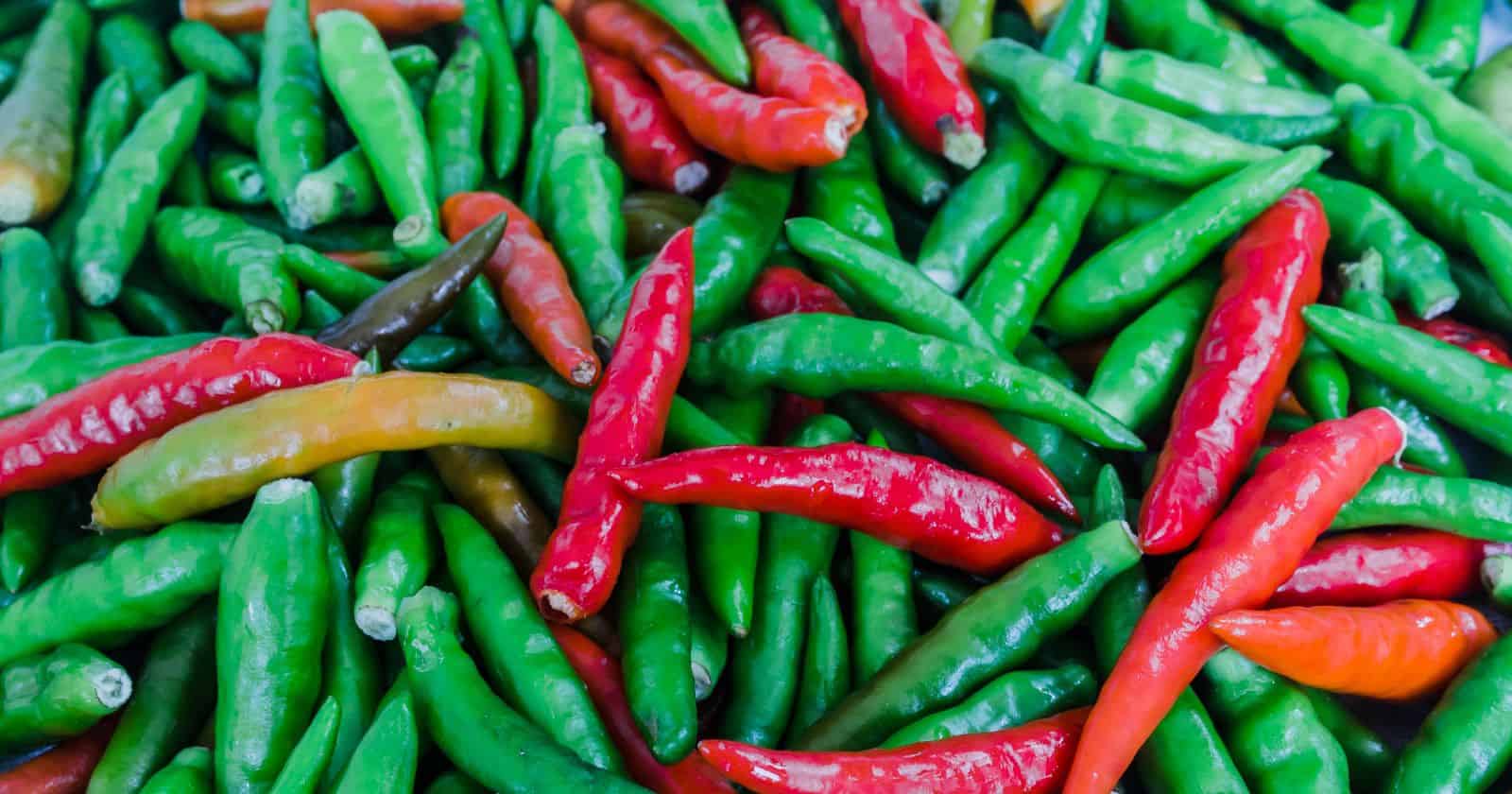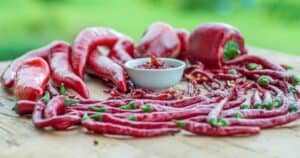Many of us have wondered if all peppers eventually turn from green to red as they ripen. The short answer is no – some peppers remain green even when fully ripe!
While certain varieties like bell peppers do change color as they mature, others like jalapeños and serranos stay green. So what determines the final shade?
It’s all about pigments! As peppers ripen, levels of carotenoids like lutein and beta-carotene increase. This enriches the yellow, orange and red hues. Meanwhile, capsanthin and capsorubin boost red tones specifically. Green peppers simply have lower concentrations of these colorful compounds.
Of course, some environmental factors also influence color:
- Sunlight
- Warmth
- Growing time
Ripening does impact flavor and nutrition too. For example, red bell peppers tend to be sweeter and have more antioxidants than their green counterparts. But jalapeños pack just as much heat when green as when fully mature!
So the next time you’re browsing the produce aisle, remember – not all peppers follow the same color changes. Now let’s explore why this happens and how it impacts taste and health benefits!
Why Do Some Peppers Change Color?
First, let’s look at the key pigments that create the range of hues in peppers:
- Chlorophyll – This green pigment dominates in unripe peppers. As chlorophyll breaks down, other colors emerge.
- Carotenoids – These organic pigments produce bright yellow, orange, and red. Examples are lutein, capsanthin, and lycopene.
- Anthocyanins – These impart blue, purple, and red shades.
So green peppers get their color primarily from chlorophyll. As peppers ripen, chlorophyll levels fall as carotenoids and anthocyanins increase. The specific carotenoids and their concentrations determine the final color.
Bell peppers offer a perfect example of this ripening process:
- Green – High in chlorophyll, with small amounts of lutein for pale green tones.
- Yellow – Chlorophyll gone, higher lutein content for vivid yellow.
- Orange – Rising beta-carotene enriches the orange hues.
- Red – Lycopene and capsanthin accented with anthocyanins create deep red.
For peppers that turn color, the more time spent ripening on the plant, the more dramatic the color changes thanks to accumulating carotenoids.
Why Do Some Peppers Stay Green?
Not all peppers undergo such vivid transformations, however. Chili peppers in the species Capsicum annuum, like jalapeños, serranos, and poblanos, remain green even when fully ripe. What gives?
These varieties simply produce less of the colorful carotenoids during ripening. They retain higher chlorophyll levels and lower concentrations of pigments like capsanthin and capsorubin that enrich red tones.
Therefore, green chili peppers reach peak ripeness without shedding their verdant shade. Their hot, aromatic flavors develop fully while chlorophyll keeps their color bright.
Other Factors Influencing Pepper Colors
While variety plays a major role in determining pepper colors, other factors come into play as well:
Sunlight Exposure
- More sun = more carotenoids = deeper red shades
- Shaded peppers with less light stay paler
Temperature
- Warmth enables more carotenoid production
- Cool conditions inhibit pigment accumulation
Length of Growing Time
- Quick-maturing peppers won’t get as red
- Longer season = more time to synthesize pigments
Growing Conditions
- Healthy, vigorous plants will ripen more fully
- Stress can impede pigment production
So even for typically red varieties like bells, full sun, warm temps, a long season, and optimal care will maximize vivid ruby hues. Green chili peppers also deepen a bit in strong sunlight.
When Are Peppers Ready to Pick?
Since not all peppers change color as they ripen, it can be tricky to know when to harvest them at peak maturity. Here are some tips for key varieties:
Bell Peppers
Wait until bells reach their final color – green, yellow, orange, or red. Glossy, firm skin and full shape indicate ripeness.
Poblanos
Harvest when the dark green skin develops a creamy undertone. Ripe poblanos will also feel firm.
Jalapeños
Look for firm, smooth skin with sheen. Size is a better indicator than color. Leave on plant until jalapeños grow to desired size.
Serranos
Like jalapeños, harvest based on size when serranos are bright green and firm. Waiting for red hues means overripe peppers.
Habaneros
Once habaneros develop their trademark orange-red tones, subtle wrinkling, and fruity aroma, they’re ready for picking.
The takeaway? Use size, texture, fragrance, and varietal color clues – not just redness – to determine prime ripeness.
How Does Ripeness Impact Flavor and Heat?
You might think fully red peppers are always more flavorful than green ones. But for some varieties, peak tastiness happens long before vibrant hues set in. Here are a few insights:
- Bell peppers – Red bells are sweeter due to higher sugar content. Green bells tend to be more bitter.
- Poblanos – Ripe poblanos have richer flavor than unripe green ones.
- Jalapeños – Spiciness and flavor are equally good whether jalapeños are green or red.
- Serranos – Bright green serranos are ideal. Red ones tend to lose their signature heat and zing.
- Habaneros – Vibrant orange-red habaneros are fruity and extremely hot. Green ones are not yet ripe.
So don’t assume red means tastier or spicier! The optimal time to pick varies for different types.
Are Red Peppers More Nutritious?
Red bell peppers do pack higher nutrient levels than green bells, thanks to increasing carotenoids as chlorophyll breaks down. For example:
- 2X the vitamin C
- 10X the vitamin A
- 1.5X the vitamin B6
- 2X the folate
But when it comes to spicy chili peppers, red and green can be nutritionally equal. So for jalapeños, serranos, etc., the health benefits are similar at any stage.
The exception is fully red habaneros, which contain beneficial lycopene found in tomatoes. But for most chilies, feel free to use red and green interchangeably in recipes without losing nutrition.
Still Wondering “Do All Peppers Turn Red?”
While many people assume all peppers will eventually turn red, it’s simply not true! Hopefully this guide gave you clarity around:
- Why varieties like bell peppers shift from green to shades of yellow, orange, and red thanks to pigments like carotenoids
- How sunlight, warmth, maturity, and growing conditions encourage color changes
- Why spicy peppers like jalapeños stay green even when ripe
- When to harvest different pepper types based on color, size, texture, and other signs of optimal ripeness
- How ripeness and color impact the flavor, heat, and nutrition of various peppers
The world of peppers is vibrant, complex, and sometimes confusing – but understanding the science behind their remarkable rainbow of hues sheds helpful light on proper growing, harvesting, and enjoying.
So next time your market offers an array of green, red, orange, and yellow beauties, you’ll know exactly how to pick the perfect peppers to brighten up your dishes!





